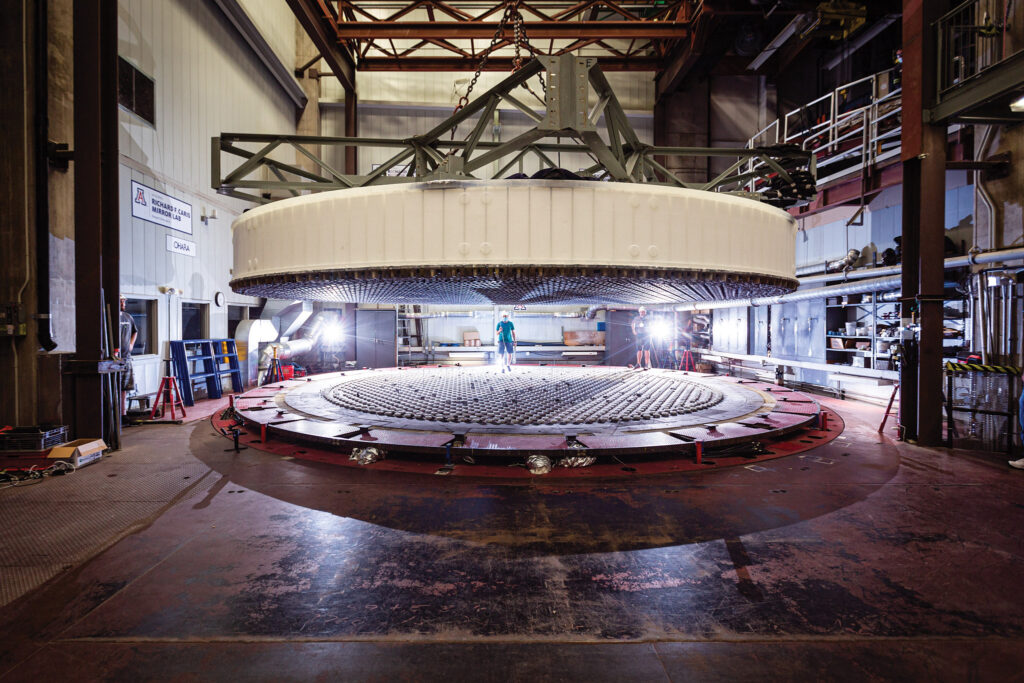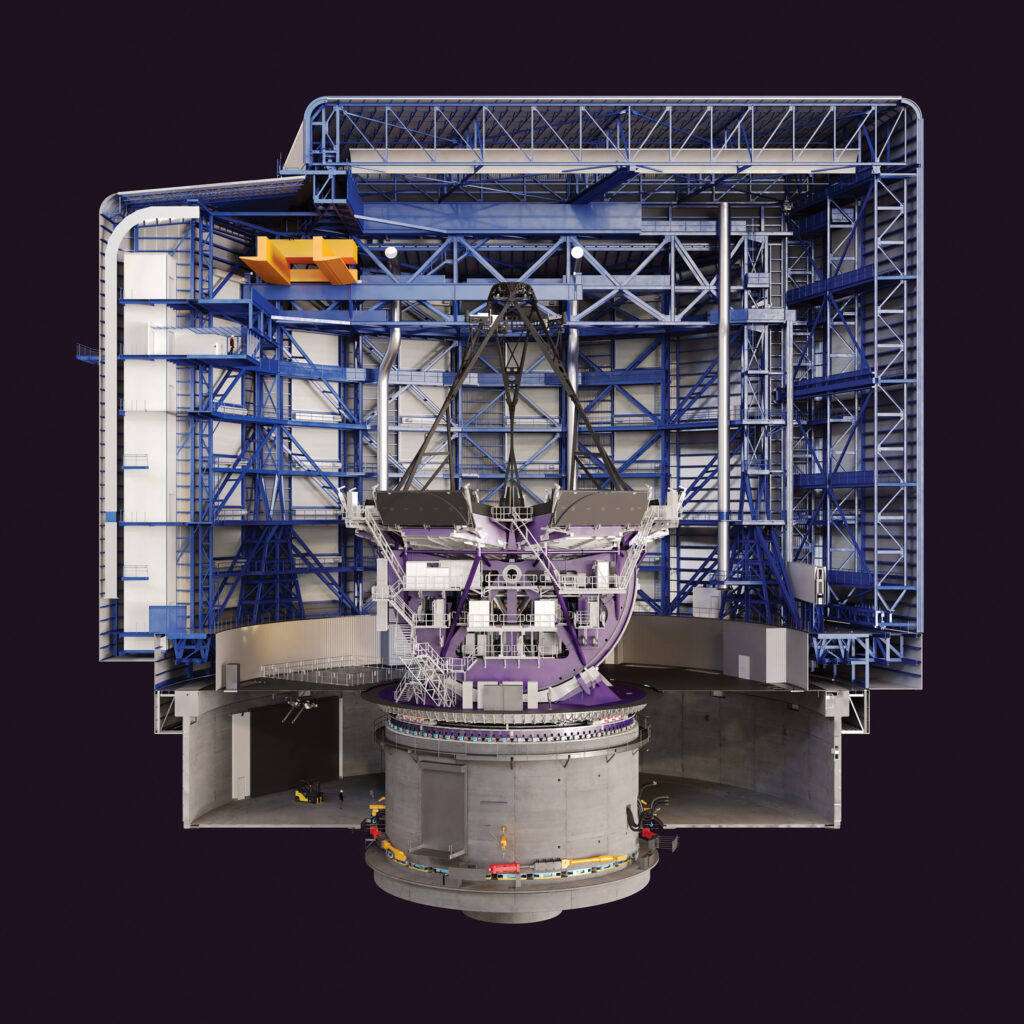UT Invests in Giant Telescope to Take Us Back in Time

About 4,500 miles south of the Forty Acres, on a desolate mountain peak in the heart of the driest desert in the world, is a large concrete circle. It doesn’t look like much today, but this slab in Chile’s Atacama Desert is the foundation for one of the most powerful portals to the universe ever conceived. It is the future home of the Giant Magellan Telescope (GMT), which will offer astronomers an unprecedented window into the early universe and billions of exoplanets across the Milky Way.
Work on the GMT has been underway for more than a decade, and there’s still a lot more to be done before it gets its first glimpse of the universe in 2029. Aside from the substantial engineering challenges that come with building a scientific instrument that can see deeper into the past than anything before it, one of the biggest hurdles faced by the GMT’s architects is ensuring that the project has enough funding to be completed on schedule. The total cost is expected to be more than $2 billion, which will make the GMT both one of the world’s largest telescopes and one of the most expensive.
As a founding member of the consortium of universities and research organizations responsible for shepherding the telescope from conception to completion (known as the GMTO Corporation), The University of Texas has played a critical role in both the scientific and financial aspects of the project. In August, UT committed $45 million in funding for the telescope as part of a $205 million funding package supported by Harvard University, the Carnegie Institution for Science, the São Paulo Research Foundation, the University of Arizona, and the University of Chicago. It brings UT’s total commitment to the telescope to just over $110 million, which will go a long way toward accelerating the construction of this one-of-a-kind observatory.

Since 1996, UT has operated one of the world’s largest optical telescopes—meaning it collects light in the visible part of the spectrum as opposed to, say, X-rays—at the McDonald Observatory in the Davis Mountains of West Texas. Known as the Hobby-Eberly Telescope, it has allowed UT astronomers and their collaborators to make amazing discoveries, including the detection of Earth-like planets around other stars and what may be the largest black hole ever found. The Hobby-Eberly Telescope was—and continues to be—an amazing scientific instrument. But “to address the latest scientific problems, we need to go larger,” says Taft Armandroff, the director of UT’s McDonald Observatory and vice chair of the GMTO Corporation board. “So, we’re collaborating with some of the most ambitious and best astronomy programs as a consortium to build the GMT.”
When it comes to the performance of an optical telescope, it’s all about how much light its sensors can collect. One way to do that is to place the telescope in a location where the skies are dark and clear, which is why the GMT is being built on top of a mountain in the middle of the Atacama Desert. But a more important parameter is the size of the telescope’s mirror. You can think of a telescope mirror as a bucket for collecting light particles—or photons—and the larger the mirror’s collecting area, the more photons it can collect.
The GMT has seven primary mirrors that, combined, equal the equivalent of a mirror that is 25.4 meters—or 83 feet—in diameter. To put that in perspective, the GMT has about five times the collecting area of UT’s Hobby-Eberly Telescope and about four the area of NASA’s recently launched James Webb Space Telescope, which is studying the universe from about 1 million miles away from Earth in deep space.

Its massive mirrors mean the GMT will be able to see far fainter light sources such as ancient galaxies and distant exoplanets in greater detail. And given how fast the James Webb Space Telescope has already transformed our understanding of the universe, astronomers expect to see comparable breakthroughs from the GMT.
“GMT is a big step change for telescope capabilities,” says Steve Finkelstein, an associate professor and the Isabel McCutcheon Harte Centennial Chair in Astronomy at UT. “I can’t forecast exactly what the huge discoveries will be, but I have no doubt that they will be there.”
For Finkelstein, one of the most exciting applications for GMT will be studying the formation of the first stars and galaxies during a period in the early history of the universe known as reionization. The light from these first stars and galaxies has been traveling through space for more than 12 billion years, which makes it incredibly difficult to detect without a massive telescope. The same goes for exoplanets in our own galaxy, which are incredibly faint compared to the brightness of our host star. But with the GMT’s massive mirrors and sophisticated equipment, astronomers should be able to get a clear enough view of these exoplanets to study their atmospheres.

Although Finkelstein and his colleagues won’t be able to use the GMT before the end of the decade, UT’s investment in the telescope is already transforming its astronomy department. Like any university, UT competes with other organizations to attract the best talent. “When we ask these early career professionals what clinched the deal to come to UT,” Armandroff says, “they’ve often said that it was because they were going to be part of GMT and have preferred access to the telescope for themselves, their postdocs, and their students.”
Armandroff sees an incredible opportunity to use UT’s access to the GMT to improve astronomy education for students across the university. Given how many non-majors take astronomy courses at UT, the university’s involvement with the telescope is a unique opportunity for them to engage with the universe using cutting-edge equipment.
“The GMT will really tell us about our origins and place our history as a species within the larger astronomical history,” Armandroff says. “It’s got a lot to tell us about what a special place Earth is in the context of the universe and that, I think, is something worth thinking about for everyone.”
CREDIT: Damien Jemison, Giant Magellan Telescope – GMTO Corporation.














1 Comment